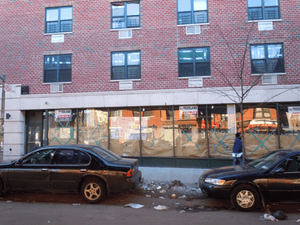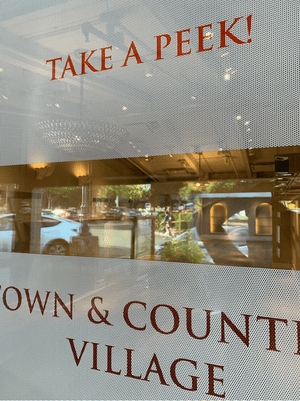How to use this guide – think of it like a cookbook!
Part of a series of toolkits for BIDs, this guide is filled with easy-to-follow “recipes” for creative ways a BID can approach its inactive storefronts. The recipes selected were identified through outreach and consultation with the New York City Department of Small Business Services, BID leaders and practitioners. Each recipe is designed to offer BID practitioners a step-by-step set of actions, together with an understanding of key implementation details, including level of difficulty, magnitude of cost, lead time, necessary partners, and options for monitoring success.
The Recipes
Vacant Storefront Activation Basics
First things first: Vacant storefronts are privately owned. This means that addressing the challenge of vacancies means building close, trusting relationships with property owners, and understanding and responding to their motivations. Vibrant BIDs enhance property values and rent potential for landowners, however gaining public access to a retail space carries significantly more legal risk for a landlord than simple window activation. Liability is often a significant concern preventing landlord engagement. Landlords do not want to be liable if a visitor injures themselves on the property, a concern that can stand in the way of any form of public space activation. In instances where liability concerns cannot be overcome, window activations that eliminate legal liability are a feasible option.
Yet another consideration for landlords is rent and the “hassle factor”. While experience suggests that short-term activations can actually shorten the time it takes to lease a space permanently, landlords may not want to tie up a space that is actively being leased for fear of detracting or delaying occupancy by permanent tenants. Furthermore, pop-up users are not often deep pocketed businesses with the ability to pay full-freight rent. Landlords may not want the hassle of handling legal liability or negotiating short-term leases if they think a permanent tenant may be right around the corner. Yet overcoming landlord resistance is possible by having a good relationship with them and banking contributions and goodwill over time.
The Recepies
Each recipe below is designed to offer BID practitioners a step-by-step set of actions, together with an understanding of key implementation details, including level of difficulty, magnitude of cost, lead time, necessary partners, and options for monitoring success.
Agreement Considerations
Management of an exterior window activation is far simpler than an interior pop-up activation. A lease is not needed; only a simple use agreement with the owner of the building. The agreement should stipulate the terms of the short-term use. While the terms oof the agreement will vary slightly based on the type of activation, before are key elements to consider.
Length of the term. It is simplest to have the entire program sign for the same term, such as a three-month program, but you could adjust the term based on the landlord or the activation.
Utilities. The store owner should ensure coverage of the utilities. Specifically, electrical since lighting will be required for the window activation.
Details for how the exterior and interior window space may (or may not be) altered, along with stipulations that improvements or alterations of any kind must be discussed with the landlord.
Repair responsibilities and timelines. Either the program coordinators or the landlords will be for ensuring lights work for the duration of the installation. Who will monitor the project and how often? If a bulb goes out, who will repair it?
Clear understanding of responsibility for any personal or property damage resulting from the installation. This would be unusual, but if the window installation somehow damages the building (or more rare, incites someone to damage the building) who would be held responsible?
Statements outlining what is allowed and what would trigger immediate termination of the agreement. This may include outlining language or imagery that you want to prohibit.
Window activations are a relatively quick and easy intervention that can have significant impacts. They also pose minimal liability risk to a property owner and can be used to camouflage spaces that need more significant tenant improvements.
Helpful Tip: Work with your vendor to select images for a window cling that reflects the type of retail that would enhance the corridor’s existing tenant mix. For example, if you want a gym, put up images of people working out. Also, be sure any painting or window cling is affixed to the window interior to protect the image from weather damage or vandalism.
Lesson Learned
Enhanced BID retail recruitment efforts, beyond those outlined here often involve a BID playing a role that is more akin to a broker. This may be appropriate when property owners lack the motivation and/or local brokers express limited interest in leasing spaces in the district. If the BID elects to take a more pro-active approach to tenant recruitment effort, we recommend the ICSC publication entitled “Improving Tenant Mix: A Guide for Commercial District Practitioners”, which outlines an easy to follow eleven-step process for BID-led retail recruitment, for further reference.


Source: Downtown Fresno

Source: Downtown Fresno

Source: Etsy Handbook, “How to Organize a Pop-Up Shop”
License/Lease Considerations
In the case of a temporary pop-up, you may be able to use a license rather than a lease. A license gives the licensee the legal authority to use the landlord’s asset. Generally, licenses are given out for short-term occupants. In either case, the agreement should stipulate the terms of the short-term space use. While these terms could vary depending on use, below are key elements to consider.
Length of the term. It is simplest to have the entire program sign for the same term, such as a three-month program, but you could adjust the term based on the landlord or the activation. For longer-term programs without a clear end date, you should be able to promise at least 60 days to make it worthwhile for the short-term occupant and then have a rolling 30 day expulsion clause for no cause going forward to allow for the space to be rented and temporary uses to cease.
Utilities and garbage. Simplest would be for the owner to continue to cover all utilities and garbage removal during the temporary period, and for the tenant to pay a flat fee for rent.
Details for how the space may (or may not be) altered, along with stipulation that improvements or alterations off any kind must be discussed with the landlord.
Hours of access. The lease should include an limitations on access to the store, including hours and/or days of the week. The agreement might also include a requirement minimum hour of operation by the tenant to ensure the tenancy results in an open and active storefront to meet the goals of the program.
Repair responsibilities and timeliness. Typically, tenants would be responsible for general upkeep such as cleaning or minor repairs (such as interior paint touch-ups or light bulb replacement). Landlords would be responsible for structural or utility repairs. Since this is a short-term lease, the agreement should include a requirement on the speed of repairs to electrical, plumbing, and mechanical systems should there be an issue. Landlords should consider their ability to complete repairs in a timely manner before entering into an agreement.
Clear understanding of responsibility for any personal or property damage resulting from tenancy. This protects both the landlord and the tenant.
Statements outlining what would trigger immediate termination of the agreement, such as uses you want to prohibit. This strategy to mitigate activity that the property owner or third-party master-agreement holder believes will significantly increase their liability. Examples might include hosting un-approved events in the space, making un-approved modifications to the space, using the space at unauthorized hours, or the presence of illegal substances on site.
Penalties if the tenants do not comply with the program. For example, the tenants might have to reimburse the city for grant money received and/or opportunity costs lost.
Before you market your available spaces, consider the checklist below developed by Linda Farha, Founder and CEO of Pop-Up Go, a pop-up listing website. Any listings should include at minimum the following information.
Pop-up checklist
General Location Questions
What is your overarching vision for the area?
Who are your target audiences?
Provide demographic and other relevant information.
How many spaces are available for pop-ups?
Individual Space Questions
- Where is the space located?
What floor?
Does it have street access?
Does it have street-front windows?
What size is the space?
What amenities are included with the space?
Bathroom
Parking
Storage
Security/Alarm system
Internet (wifi)
Telephone (land/mobile)
Gas, Water, Electricity, Trash, etc.
Fire alarm
Permitting and approval requirements
Signage
- When are the spaces available?
Are there any timing restrictions?
Minimum terms?
Are there any physical restrictions on the space?
- What category of pop-up would you like to attract in this space?
Food
Fashion
Health
Beauty
Home
Entertainment
Event
Art
Jewelry
Accessories
Fitness
Other
Checklist provided by Linda Farha, Founder and CEO of Pop-Up Go
Images sourced from Sustainable Fashion Community Center; CultureHouse Peabody, Cambridge, MA; and Hudson Square BID courtesy of SBS
Resources
- ICSC Guide to Improving Tenant Mix
- Storefront Activation Toolkit prepared for the Commonwealth of Massachusetts Rapid Recovery Program, 2020
- The CultureHouse Handbook: How to Create a Pop-Up Community Space
- Shopify What is a Pop-Up Shop and How to Set Up one
- Musicant Group Toolkit for Activating Storefronts
Acknowledgements
Authored by
-
Larisa Ortiz
Streetsense, Managing Director, Public Non Profit Solutions
-
Emily Morin
Streetsense, Research Analyst
This checklist and the BID Toolkits were developed thanks to generous support from the NYC Department of Small Business Services and The Association for a Better New York (ABNY).
Funded By


Produced With

Related Reports
530













